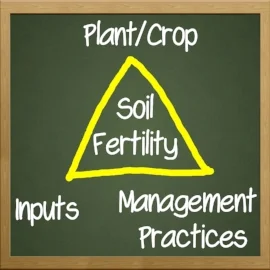Six Things Every Soil Test Should Include
Last week I wrote about four things your agronomist should know about you. One critical piece of information when working with an agronomist is having a soil test. It is the starting point for them to be able to build a fertility plan that makes financial and environmental sense for you and your farming system.
One challenge I face when working with farmers is not that they haven’t gotten a soil test done. However, the results are missing critical pieces of information that are needed to make the best recommendations tailored to their specific situation. Soil test results are a snapshot of what was happening than when it was collected. However, without the entire picture making the best fertility choices can cost you financially and have unforeseen environmental impacts both on and off your farm. Investing a few minutes and dollars can ensure you get all the necessary information that will save you in the long run.
1. pH
pH is the potential amount or concentration of hydrogen ions in the soil. It is represented by a negative logarithmic scale, zero through 14. Acidic soils, represented by a pH of below 7.0, have a higher concentration of hydrogen ions available. Alkaline soils, represented by a pH above 7.0, have a lower concentration of hydrogen ions available. It is how many hydrogen ions are in that particular soil. – Talk to the Blueberries
pH is the foundation of all soil chemistry. In which it plays a role in microbial activity that drives nutrient reactions in the soil directly affecting plant health and yields.
2. Organic Matter (OM)
Often, I refer OM to being the pantry that microbes have access to, where nutrients are stored that plants need. Due to the fact this fraction of the soil acts as a holding area, or pantry, for several nutrients, it is essential to know what percentage makes up the soil in a given sample.
OM plays a role in storing a vital nutrient, such as nitrogen. The estimated amount of nitrogen (lbs./ac) that can be released or ENR that can potentially be available over the growing season is relative to the percentage of OM present in a soil. The decomposition of organic matter can release about 20 lb. N/acre/year for each percent of organic matter. Knowing these amounts can help to adjust nitrogen inputs throughout the growing season leading to better cover crop choices, more productive crop rotations, and increase the efficiency of a fertility program.
Depending on the lab, this may not be included in a standard package and can often be overlooked. Pay close attention to the soil sample submittal form, making sure it is tested for each sample.
3. Cation Exchange Capacity
If OM is the pantry where the nutrients can be stored, cation exchange capacity or CEC is the number of shelves or sites you have to store nutrients such as calcium, magnesium, potassium, and other positively charged ions.
Say, for example, I have two pantries’ in our home, one with eight shelves and a smaller pantry with two shelves. That gives me a total of ten shelves to place food on for storage. Clay, which is predominantly negatively charged, could potentially be the pantry with eight shelves and be able to store nutrients that have a positive charge. OM could be the pantry with two shelves, being made up of both negatively and positively charged ions, can store either. In the case of nutrient storage in soil, how much and where it is relative to the amount of clay and OM, and the sum is referred to as the Total Cation Exchange Capacity (TCEC).
4. Base Saturation
Base Saturation is a percentage of a nutrient, or cation makes up the TCEC. How much shelf space in the pantry that particular cation is occupying in relationship to the total size of the pantry. When it comes to balancing soil nutrients, there is a school of thought that uses percent base saturation results. Whether that is the measure you are using to adjust nutrients or not, it is still a good overview as to the ratios nutrients are present in the soil. And can be used to help determine the most useful input to achieve the desired balance of nutrients based on other factors as well.
Nutrients that should be included are
Potassium (K), Calcium (Ca), Magnesium (Mg), Hydrogen (H), and Sodium (Na)
5. MacrONutrients
For this post, which is to make sure farmers get the appropriate test results for an agronomist to make sound and relevant recommendations, I am listing nutrients that a standard soil test should include, and as they are categorized by most labs across the country. For example, I could go into more detail talking at length regarding Nitrate testing and the categorization of sulfur being a micronutrient as opposed to a macro. But that’s not the point of this post. What a farmer needs to have reported in the results are the following essential nutrients that make up the majority of a plants diet including-
Calcium, Magnesium, Potassium, and Phosphorus
6. MicrONutrients
Sometimes referred to as trace elements, due to the fact they are required in smaller amounts than the previously listed macronutrients.
These should include sulfur, zinc, boron, copper, manganese, and iron. Depending on the lab, sodium could be reported under this category as well. I’ve listed them in importance for how and why I make fertility recommendations. Farmers need to note that some labs charge per element or as a group. You have to be diligent when filling out the soil sample submittal form, including ones that are pertinent to your situation.
Don’t let a few extra minutes or a couple of extra dollars keep you from getting-













